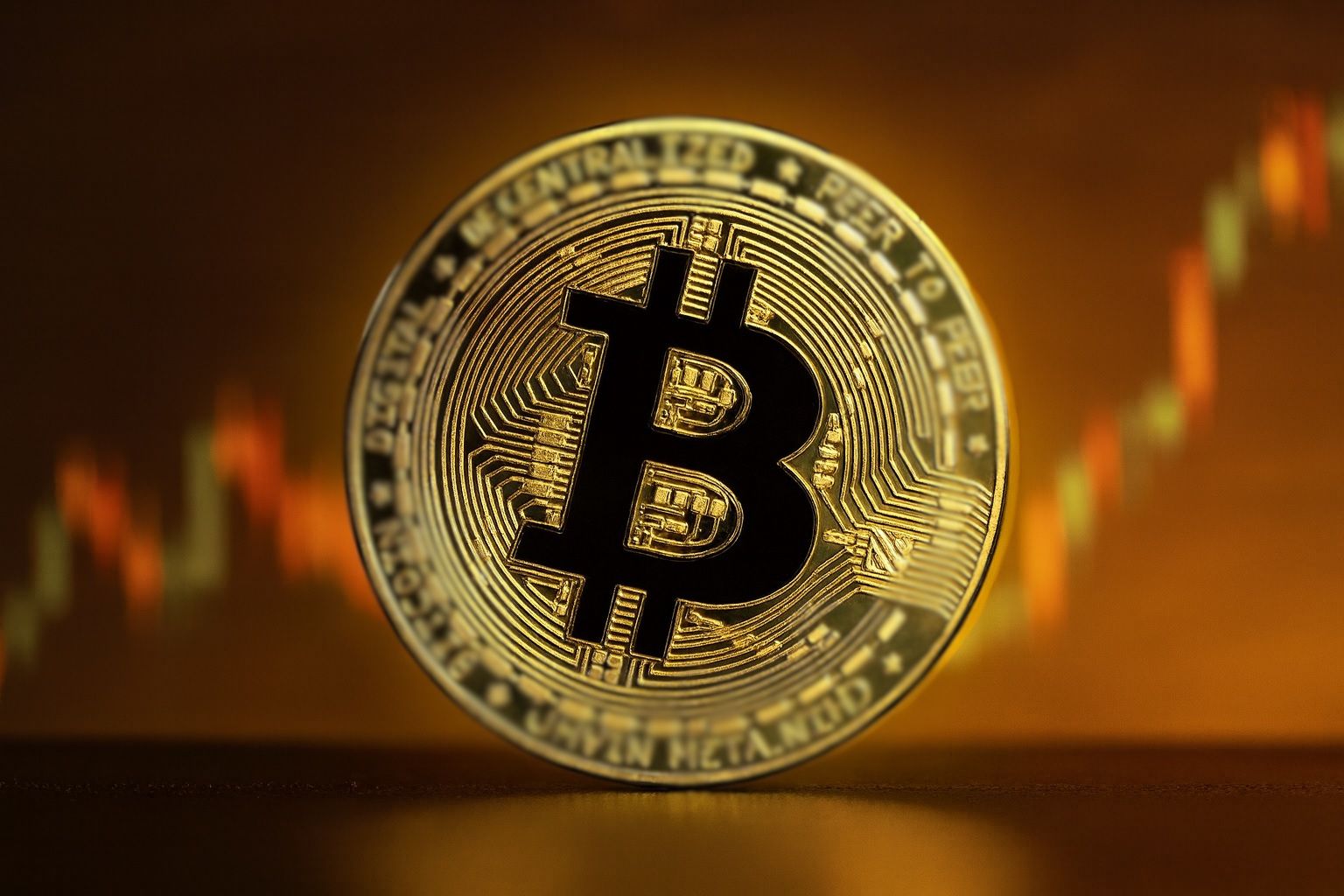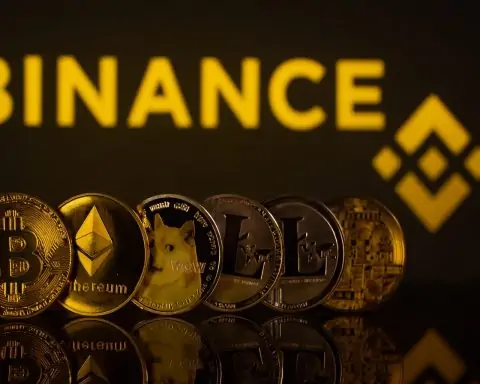- Bitcoin Back Above $114K: Bitcoin (BTC) is trading around $114,500 as of October 28, 2025, recovering from a mid-month slump [1]. The price is up roughly 5% over the past week after a strong weekend surge, though it remains about 8–10% below its early October all-time high around $125K [2] [3].
- Recent Rally Drivers: Optimism over an imminent U.S.–China trade deal and expectations of a Federal Reserve interest rate cut this week have boosted risk appetite across markets. Bitcoin jumped past $116,000 over the weekend on hopeful trade talk comments from President Trump [4], and traders are pricing in a near-certain 0.25% Fed rate cut on Oct. 29 [5] – macro catalysts that historically favor Bitcoin as a hedge against a weaker dollar and inflation [6].
- Volatility and “Uptober” Comeback: October has been a roller coaster for crypto. Bitcoin hit a record ~$125,000 on Oct. 5 amid massive ETF inflows and bullish sentiment [7] [8], then plunged to near $104K in a single day on Oct. 10 when a sudden 100% U.S. tariff threat against China shocked markets [9]. That crash – the largest ever crypto liquidation event ($19B+ in positions wiped) – briefly sent sentiment to “extreme fear” [10]. However, BTC has steadily climbed back in the latter half of “Uptober,” regaining confidence as trade tensions eased and buyers stepped in [11] [12].
- Altcoins Joining the Surge: The rally is broad-based. Ethereum (ETH) is back above $4,200, up ~4% this week [13], after bouncing from a mid-October dip (it briefly fell to ~$3,637 during the sell-off) [14]. Other top cryptos like Solana (SOL) have doubled from summer lows and recently cleared $200 again [15]. Smaller altcoins are mixed – Hedera’s HBAR token spiked 17% on news of a new ETF launch [16] [17], while many others are still regaining lost ground. Overall crypto market capitalization has climbed ~5% over the past week, nearing $3.8 trillion (close to year-to-date highs) as confidence returns.
- Institutional Inflows vs Retail Momentum: Large investors are increasingly piling in. In the first week of October, crypto funds saw nearly $6 billion of inflows, including ~$3.5B into Bitcoin-focused ETFs, which helped propel BTC to its record high [18] [19]. Institutions and corporate treasuries now hold roughly 12% of all Bitcoin supply, an unprecedented share [20]. However, retail traders remain a major force – analysts note we’re still in “early innings” of institutional adoption, with individuals (including high-net-worth clients via ETFs) owning the bulk of Bitcoin assets [21] [22]. U.S. investors have been buoyed by a more crypto-friendly policy environment (President Trump has called himself a “crypto president”), including moves toward the first federal digital asset laws and spot ETF approvals [23] [24].
- Expert Forecasts & Outlook: The market’s resurgence has prompted bold predictions – Standard Chartered analysts recently projected Bitcoin could reach about $200,000 by end of 2025 if current trends continue [25]. Even traditionally conservative banks like Citigroup foresee BTC in the $130K+ range in the next year [26]. In the near term, some see a potential re-test of the $120K-$125K zone in the coming weeks if ETF-driven buying and macro tailwinds persist. Still, others urge caution: Citi’s models warn a severe downturn could drag Bitcoin to ~$80K [27], and veteran investor Robert Kiyosaki has raised the possibility of a “massive crash” – though he recommends holding Bitcoin (and gold) as a hedge regardless [28]. Most analysts expect high volatility to continue, and are watching key support around $105K and upcoming economic events closely.
Bitcoin Rebounds to $114K After Wild October Swings
Bitcoin’s price is hovering near $114,000–$115,000 on October 28, marking a strong comeback after this month’s dramatic swings [29]. Just a few weeks ago, the world’s largest cryptocurrency was in freefall – on October 10 it plunged from the mid-$120Ks to almost $104K within hours amid a global market shock [30]. That sudden drop came after U.S. President Donald Trump stunned markets by announcing a 100% tariff on Chinese exports, which sparked a flight from risk assets worldwide. Crypto was hit especially hard: by that Friday evening, Bitcoin had fallen ~8.4% to about $104,782, and Ether about –5.8% to $3,637 [31]. More than $19 billion in leveraged crypto positions were liquidated in 24 hours – the largest such wipe-out on record [32] – as cascading margin calls accelerated the crash.
The mid-October rout briefly sent crypto sentiment into deep fear. (The popular Fear & Greed Index for Bitcoin collapsed from “Greed” above 70 earlier in the month to just 24, or “Extreme Fear,” at the height of the sell-off [33] [34].) But notably, that panic was short-lived. By October 12, buyers cautiously returned, stabilizing BTC around the $111K–$112K level – roughly 10% below its peak [35]. Market observers noted that the worst of the forced selling had likely passed, as those rapid liquidations flushed out weaker leveraged positions [36]. Over the next two weeks, Bitcoin steadily ground its way back up. The period that began with “tariff shocks and flight to safety” evolved into a far more optimistic narrative by late October [37]. As of today, BTC has regained about +10% from its mid-month lows, bringing it within striking distance of its record high (set earlier in the month) and restoring a neutral-to-bullish tone in the market [38] [39].
Why $114K matters: At ~$114.5K, Bitcoin is trading at a level not consistently seen since the start of October [40]. Analysts point out that this price area (around $113K) corresponds to the average cost basis of many recent buyers, meaning the market has now moved back above a key pivot that could have triggered further capitulation had prices stayed below it [41] [42]. In other words, the latest rebound eased pressure on late entrants who bought high – relieving a potential source of selling. “Confidence is tiptoeing back into crypto,” noted one Cointelegraph report, as the Fear/Greed gauge has now climbed out of fear for the first time since the crash, landing around a neutral 50–55 reading [43] [44]. The return of calmer sentiment sets the stage for Bitcoin’s next move, with traders debating whether fresh catalysts could propel a breakout toward new highs, or if a period of consolidation (or even another pullback) might be in store after such a brisk recovery.
Trade War to Trade Truce? Macro News Lifts Markets
A major factor behind Bitcoin’s resurgence has been a positive turn in macroeconomic news – chiefly on U.S.–China trade tensions and central bank policy. Earlier in the month, the escalating trade war delivered a gut punch to crypto. But now the narrative has flipped to hopes of a trade truce. Over the past week, officials from Washington and Beijing have signaled progress toward an agreement that would defuse the tariff standoff. President Trump struck an upbeat tone, saying he “really feel[s] good” about the chances of a deal that could avert the looming 100% tariffs in exchange for compromises on tech and rare-earth exports [45]. This optimism was echoed by U.S. Treasury officials over the weekend, and markets responded in force.
Global equities rallied on the hints of a deal, giving Bitcoin a boost as well [46]. In fact, BTC briefly spiked above $116,000 on Sunday after Treasury Secretary Scott Bessent’s positive comments, before settling back in the $114–115K range Monday [47] [48]. Crypto and stocks have often moved in tandem lately when major macro drivers are at play, and late October has been no exception. The S&P 500 and Nasdaq indices both notched record highs in recent days, helped by the trade-deal buzz and strong earnings, and Bitcoin appeared to piggyback on that risk-on wave [49] [50]. As Bloomberg noted, “equities rallied as signs that the US and China were closing in on a trade deal stoked optimism”, underscoring how deeply intertwined market sentiment has become [51] [52].
Another closely watched catalyst is the U.S. Federal Reserve. After a year and a half of interest rate hikes, the Fed has shifted to a more dovish stance as economic pressures ease. It already delivered a 0.25% rate cut in September, the first of 2025, and now a second cut is widely expected at this week’s FOMC meeting concluding Oct. 29 [53] [54]. Futures markets put the probability of an October cut at over 95% – essentially a done deal [55] [56]. For Bitcoin, easier monetary policy tends to be favorable: lower rates and a potential weaker dollar can increase the appeal of alternative assets like crypto. “A weaker dollar and lower rates are generally tailwinds for Bitcoin, pushing investors toward alternatives,” as analysts note [57]. Inflation in the U.S. has come down from its peak but is still around ~3% (above the Fed’s 2% target), which adds to Bitcoin’s narrative as “digital gold” – a scarce asset that some investors use as an inflation hedge when real yields fall [58]. Indeed, while BTC has rallied more than 10% off its October lows, traditional gold has also been strong this year (recently near an all-time high around $4,000/oz before a slight pullback) [59]. Both assets seem to be benefiting from the so-called “debasement trade” – the idea that with heavy government spending and monetary easing, fiat currencies may lose value, so investors flock to hard assets [60]. This macro backdrop of cooling inflation, falling interest rates, and a hopeful geopolitical outlook has provided a supportive foundation for Bitcoin’s late-month rally [61] [62].
It’s worth noting that broader economic currents remain in flux. Traders are keeping a close eye on the Fed’s tone (will it signal further cuts ahead or a pause?) as well as any concrete news from the expected Trump–Xi meeting on trade. Also in focus is whether the U.S. government can avoid another shutdown in coming weeks, and how global growth is holding up. But for now, the market seems to be breathing a sigh of relief that worst-case scenarios – from an all-out trade war to runaway inflation – have not materialized. That improved sentiment has enabled Bitcoin and other risk assets to climb together. As one strategist put it, “what began as a month defined by tariff shocks and flight to safety has evolved into a more upbeat narrative of potential trade peace and market stability” [63] [64].
Ethereum, Altcoins and the Wider Crypto Market
Bitcoin’s resurgence has lifted the entire crypto market, though different coins are recovering at different paces. Ethereum (ETH), the second-largest cryptocurrency, is trading near $4,200–$4,300 today – a level it hasn’t seen consistently since the spring. Ethereum had a standout start to October, briefly hitting $4,879 on Oct. 10 (just above its all-time high from 2021) amid the broader rally [65]. The subsequent crash sent ETH tumbling into the mid-$3,600s at its worst [66], but like Bitcoin, Ether has rebounded sharply. It’s now up roughly 4% week-over-week [67] and about 15% above its mid-month low. Importantly, Ethereum’s fundamental trends appear strong: network usage is rising (with active DeFi applications and layer-2 “scaling” networks drawing in users [68] [69]), and big Ether holders have been accumulating. Analysts note that the amount of ETH held on exchanges has been dropping, which suggests more investors are moving coins into long-term storage or staking contracts rather than leaving them liquid for potential sale [70] [71]. The ETH staking rate – enabled by the network’s recent upgrades – continues to hit new highs, effectively sidelining a portion of supply and potentially adding upward pressure on the price by constraining circulating supply [72] [73].
There’s also speculation that the first U.S. spot Ethereum ETFs could win approval in the coming months [74]. Such a development would mirror Bitcoin’s ETF-driven adoption and could funnel fresh institutional money into ETH. In fact, during early October’s inflows frenzy, roughly $1.48B went into Ethereum investment products alongside the larger Bitcoin inflows [75]. Major financial players have taken notice: several banks and research firms have reportedly raised their ETH price targets, with a few even suggesting year-end targets in the $7,000–$8,000 range if adoption accelerates [76] [77]. Those forecasts are optimistic, but they highlight a growing view that Ethereum – which underpins a huge swath of blockchain activity from smart contracts to NFTs – could see outsized gains if the crypto rally broadens beyond Bitcoin. For now, ETH’s price trend is positive, and interestingly, its ratio against BTC (ETH/BTC) has stabilized after slipping earlier when Bitcoin outperformed [78]. This hints that altcoins are starting to “catch up” as the market recovery widens.
Other altcoins are mixed but generally on the upswing. Solana (SOL), often dubbed a “third-generation” blockchain, has been a top performer in this “Uptober” rally. SOL’s price has roughly doubled since early September and recently broke back above $200 per coin [79] [80]. Enthusiasm for Solana comes from a string of upbeat developments: its network activity (daily transactions, active addresses) is climbing again, and new decentralized finance and NFT projects on Solana are renewing investor interest [81]. Some crypto funds have begun dipping toes into SOL as a diversification play, though Bitcoin and Ether still dominate institutional portfolios [82]. Technical analysts note Solana’s chart looks strong after clearing a key $200 resistance level – some see potential room toward ~$230 if momentum continues, though caution that SOL remains prone to volatility and sharp pullbacks [83] [84].
Meanwhile, XRP – the #3 crypto by market cap – is trading around the high-$2.60s to $2.70s, which is a relief for its holders after XRP plunged under $1.70 during the mid-month panic [85]. Ripple’s token got a boost earlier this year from a favorable U.S. court ruling (leading to XRP’s relisting on some U.S. exchanges), and it’s roughly holding those gains despite October’s drama. Binance Coin (BNB) has ticked back up to about $1,140–$1,160 [86] [87], reflecting modest recovery for the exchange-linked token. Other large caps like Cardano (ADA) and Dogecoin (DOGE) were hit hard in the sell-off and have bounced off their lows, though they lag Bitcoin in percentage terms as investors stick to higher-quality names for now [88].
One notable standout is Hedera (HBAR): HBAR soared over +17% in the past day, after Canary Capital announced its new HBAR-backed ETF would debut on a U.S. exchange (NYSE Arca) – a first for that particular altcoin [89] [90]. Trading volume in HBAR surged more than 300% on the news. This kind of pop shows that even during a consolidation phase, specific news (especially around institutional adoption) can spark big moves in smaller tokens. In general, risk appetite is creeping back down the market cap list. Some lesser-known coins saw even larger jumps – for example, privacy coin Zcash (ZEC) spiked over 50% this week amid rumors of a major trust product reopening [91], and a niche token called “HYPE” jumped ~28% after its project announced a $1 billion token buyback plan [92]. Such swings indicate that traders are once again willing to speculate in the crypto “fringes,” a hallmark of a more confident market.
Total crypto market value has now climbed to roughly $3.8 trillion, close to its highest of the year [93]. If Bitcoin’s rally continues, analysts say it could trigger a classic “alt-season” – where investors rotate some profits from BTC into higher-risk altcoins, amplifying their gains. Conversely, if Bitcoin stalls or pulls back, many altcoins might struggle to maintain momentum. For now, though, the multi-asset crypto rebound appears to be in full swing, reflecting a broader belief that the digital asset market has rediscovered its footing after the early October scare.
Institutional Adoption Climbs as Regulation Advances
One of the underpinnings of this 2025 rally – and a key difference from past cycles – is the growing role of institutional investors and regulated investment vehicles in the crypto market. A few years ago, crypto price action was driven overwhelmingly by retail traders. Now, institutions are not only present but increasingly significant. The clearest example is the advent of spot Bitcoin ETFs and similar funds. October’s initial surge coincided with massive inflows into Bitcoin-linked investment products: nearly $6 billion in one week, according to CoinShares/Reuters data [94]. These inflows helped catapult BTC to ~$126K on Oct. 5, an all-time high [95]. “It’s indicative of real demand – it highlights the growing recognition of digital assets as an alternative in times of uncertainty,” explained James Butterfill, head of research at CoinShares, referring to the unprecedented wave of ETF buying [96] [97].
Between ETF holdings and corporate treasuries (such as companies like MicroStrategy which hold Bitcoin on their balance sheets), institutions now control an estimated 12% of the total Bitcoin supply [98]. This institutional stake is deeper than ever before. It has provided a tailwind for prices by bringing in new liquidity and also perhaps smoothing some volatility – large funds tend to trade less emotionally than retail, and the availability of ETFs gives traditional investors a more convenient, regulated way to allocate to crypto. U.S. exchange-traded products have proliferated since the first spot BTC ETFs launched in early 2024, and now there are even Bitcoin options and futures-based funds that allow for hedging and volatility strategies [99] [100]. All of this contributes to a maturing market structure.
That said, retail investors remain crucial. Recent analyses suggest we are still in the “early innings” of institutions entering en masse [101]. For example, less than 5% of all spot Bitcoin ETF assets are held by long-term institutional players like pension funds and endowments – most is owned by hedge funds, family offices, and retail via brokerage accounts [102] [103]. In fact, many wealth managers buy these funds on behalf of high-net-worth individual clients, so the ultimate owners are often individuals even if the channel is institutional [104]. Retail trading on exchanges and apps still drives a lot of day-to-day volatility and market sentiment. In late 2024 and again in recent weeks, data from Vanda Research showed spikes in retail purchases of crypto ETFs and stocks coinciding with Bitcoin’s run-ups (notably after Trump’s pro-crypto election win and during this October’s rally) [105]. In short, while Wall Street’s footprint in crypto is expanding, the “old guard” of early adopters and individual enthusiasts continues to play a leading role in the market’s direction.
On the regulatory front, 2025 has seen significant developments that give both institutions and retail more confidence in the crypto space. In the U.S., a series of cryptocurrency-related bills advanced through Congress this summer. Notably, in July the House of Representatives passed the “Genius Act,” a bill to create a regulatory framework for stablecoins (USD-pegged crypto tokens), with President Trump endorsing it [106] [107]. The House also approved other bills to clarify the definitions of digital assets and the jurisdiction of regulatory agencies [108]. This momentum suggests the first comprehensive federal crypto laws could soon become reality – a stark change from the regulatory uncertainty of previous years. The Trump administration has openly taken a pro-crypto stance (while also opposing a U.S. central bank digital currency), aiming to foster blockchain innovation in the private sector [109]. A new Executive Order in early 2025 set a policy to support distributed ledger tech and explicitly reject the idea of a Fed-issued CBDC, contrasting with Europe’s approach [110].
Speaking of Europe, the EU’s landmark MiCA (Markets in Crypto-Assets) regulation fully took effect at the end of 2024, bringing crypto assets under a unified regulatory regime across member states. MiCA essentially extends bank-like rules and investor protections to crypto services and stablecoin issuers, providing legal clarity for companies and traders in Europe [111] [112]. This has been welcomed by industry players in the EU, as it sets clear guardrails (e.g. capital requirements for exchanges, licensing for wallet providers) which make institutional participants more comfortable entering the market [113]. Globally, other jurisdictions from the UK to Asia have also been crafting crypto frameworks, leading to a trend where regulatory clarity is gradually replacing the Wild West era. The upshot is that big financial institutions – once very cautious – are now more willing to dip into crypto. For instance, large U.S. banks like Bank of America and Citigroup are reportedly working on their own stablecoin projects or blockchain payment systems [114]. And trading firms like TP ICAP predict a growing number of pension funds and asset managers will engage in crypto by 2026 as rules get clearer [115].
All of this bodes well for long-term adoption. However, regulation is a double-edged sword: stricter oversight can also mean stricter enforcement. The industry is still mindful of potential hurdles – for example, ensuring compliance with anti-money-laundering (AML) rules, the outcome of the SEC’s ongoing posture toward certain tokens (some past U.S. lawsuits deemed a few crypto assets as unregistered securities), and how upcoming elections might alter the policy landscape. For now, though, the prevailing sentiment is that 2025 marks crypto’s mainstream breakthrough, with a more mature market structure and acknowledgment from governments that crypto is here to stay (albeit within a framework). This maturation could, over time, reduce some of the extreme volatility crypto is known for – although 2025 has shown that shocks and surges are by no means gone.
Short-Term Trajectory and Expert Predictions
With Bitcoin back near $115K, investors are naturally asking: What’s next? In the short term – the coming days and weeks – a lot will depend on whether BTC can sustain momentum to challenge its all-time high (~$126K) and possibly enter price discovery above that level. Some analysts believe the ingredients are in place for a continued push higher. They point to strengthening macro tailwinds (the Fed pivoting to easing, a potential U.S.–China trade resolution, robust stock market performance) and renewed institutional buying as signs that Bitcoin could retest the $120K–$125K zone in the near future [116]. If buying pressure from ETFs and funds remains strong, new highs aren’t out of the question. There’s even chatter about a year-end “Santa rally” that, in an optimistic scenario, could carry Bitcoin toward the next big psychological milestone – say $130K – especially if holiday retail investors pile in as they have in past bull runs.
On the bearish side, critics caution that Bitcoin has already run up significantly this year (prices have more than tripled from around $35K in January to $115K+ now). They worry the market might be overextended. One red flag would be if macro conditions suddenly deteriorate – for instance, if the Fed delivers a hawkish surprise or if the U.S.–China talks break down unexpectedly. In such a case, risk assets could see another pullback, and Bitcoin, being relatively high-beta, might correct sharply. Some technicians also note that Bitcoin’s rapid ascent left a gap in the $90K–$100K range that has not been retested; if sentiment sours, a fall toward those levels can’t be ruled out. Citigroup analysts, while bullish in their base case, modeled a downside scenario in which BTC could drop to roughly $80,000 if a severe risk-off event hit global markets [117]. That would still be well above where Bitcoin traded for most of the past decade, but it would be painful for anyone who bought near the top.
Looking a bit further out to the medium term (several months to a year), forecasts diverge significantly – reflecting crypto’s high uncertainty. On one end, we have exceptionally bullish calls: Standard Chartered recently suggested Bitcoin could reach $150K–$200Kwithin 2025 (i.e. over the next 14 months) if it clears major resistance and if institutional adoption accelerates as anticipated [118]. They argue that as Bitcoin decisively broke $100K this year, it signaled the start of a new phase, and that “if Bitcoin decisively clears ~$120K, the path is open toward the mid-$120Ks in the near term” and then potentially much higher [119]. In fact, some crypto pundits outside of banks have floated even more astronomical targets – though these should be taken with a big grain of salt. For example, there are online models (like the popular Stock-to-Flow model or various halving-cycle theories) that point to the possibility of $250K+ or even $300K Bitcoin in a blow-off top scenario next year. Those figures are far from consensus, but they contribute to the exuberance among hardcore believers.
Mainstream institutions are more restrained but still optimistic. Citi has been cited expecting around $130K by the end of 2025 [120], which would be roughly a 15% increase from current levels – a comparatively modest gain by crypto standards. And JPMorgan strategists reportedly see long-term merit in Bitcoin but caution it could settle into a more range-bound trajectory as it matures, unless a new catalyst (like significantly higher inflation or major tech adoption) emerges [121]. One big wildcard is the historical four-year cycle tied to Bitcoin’s halving (the periodic reduction in new supply issuance). The last halving was in 2024, and in past cycles, Bitcoin saw a peak roughly 12–18 months post-halving followed by a year of downturn. If that pattern holds, 2025 could be the cycle’s top with a tough 2026 ahead [122] [123]. Indeed, some veterans predict that after three consecutive green years (2023, 2024, 2025), Bitcoin might face a significant correction in 2026 – potentially giving back some of its gains as hype cools [124]. However, others argue “this time is different” to some extent: the entry of institutions and the presence of ETFs might smooth out the boom-bust cycles, preventing the kind of 80% drawdowns seen previously [125] [126]. Volatility has actually been a bit lower this cycle than in 2017 or 2021, and the blow-off euphoria phase (with retail frenzy) arguably hasn’t fully materialized yet [127] [128].
Well-known crypto figures have chimed in too. Robert Kiyosaki, author of Rich Dad Poor Dad, made headlines by warning of a potential “giant crash” across financial markets – Bitcoin included – if global debt issues unravel, but he concurrently advocates owning Bitcoin (along with gold and silver) as a hedge against exactly that scenario [129]. His stance encapsulates the duality of sentiment: even the doomsayers often see Bitcoin as either a bubble or a lifeboat, or somehow both. On the flip side, prominent Bitcoin bulls like MicroStrategy’s Michael Saylor (whose company keeps accumulating BTC) maintain that as long as central banks continue an easy money policy, Bitcoin’s hard-capped supply will make it an increasingly attractive store of value – implying prices well into six figures over time. And crypto analysts on social media – always ready with memes – have resurrected the term “Uptober” (for Bitcoin’s historically strong Octobers) and are already eyeing “Moonvember,” hoping the rally continues through year-end.
Bottom line: In the immediate term, all eyes are on that $120K+ resistance. A successful breakout above the prior high of ~$125K, especially on strong volume, could ignite FOMO (fear of missing out) and quickly carry Bitcoin to new records. Key dates to watch include the Fed decision on Oct. 29, any progress (or setbacks) in the China trade deal talks, and upcoming economic data that might influence policy (like jobs and inflation reports). For Ethereum and other majors, Bitcoin’s direction will likely set the tone – a continued BTC surge could rotate into an “altcoin season,” whereas a cooling off might cap their advances for now.
Investors should be prepared for continued volatility. Bitcoin’s path is rarely a straight line. Even within this year, 10–20% swings have happened in a matter of days based on news flow. The presence of leverage in the system (despite some traders pulling back after the Oct. 10 wipeout) means both upside and downside moves can be exaggerated. Analysts recommend keeping an eye on trading metrics like futures funding rates (which are currently positive, indicating a bullish bias) [130] [131] and options skew (showing traders paying a premium for calls, i.e. upside bets, at the moment) [132]. Those indicators suggest the market has a cautiously bullish stance right now. As long as macro conditions remain favorable and no new shocks emerge, the bias could remain upward. But if sentiment were to flip again, support levels around ~$105K (where Bitcoin found a floor after the crash) [133] and ~$90K (an area of high interest from earlier this summer) could be tested.
For the broader audience – everyday investors and tech watchers – the current Bitcoin price run-up underscores how far the crypto market has come in just a few years. At $114,000 per BTC, Bitcoin’s market capitalization is about $2.2–2.3 trillion, making it one of the most valuable assets in the world [134]. Its influence now extends into traditional finance, global corporate strategies, and even government policy. Whether one is bullish or bearish, there’s no denying that Bitcoin on October 28, 2025 sits at the center of a convergence of trends: technological innovation, macroeconomic experiments, and shifting investor psychology. The coming months will reveal if this “digital gold” can continue to shine and perhaps break new ground – or if, like past cycles, it needs to cool off before the next ascent. Either way, it’s clear that the crypto story is increasingly entwined with the broader financial narrative, making it an essential watch for investors and policymakers alike.
Sources: Bitcoin and crypto price data and historical context from TS²/TechStock² and CoinDesk [135] [136]; Reuters and Bloomberg reports on all-time highs, trade war developments, and Fed policy outlook [137] [138] [139]; analysis and commentary from TS², CoinDesk, and Reuters on market sentiment, ETF flows, and investor behavior [140] [141]; expert forecasts as noted by TS² and Yahoo Finance/Reuters [142] [143]; and additional crypto market insights from Cointelegraph and others as cited. All information is up to date as of Oct. 28, 2025. [144] [145]
References
1. www.coindesk.com, 2. ts2.tech, 3. www.reuters.com, 4. www.coindesk.com, 5. ts2.tech, 6. ts2.tech, 7. ts2.tech, 8. www.reuters.com, 9. ts2.tech, 10. ts2.tech, 11. ts2.tech, 12. ts2.tech, 13. ts2.tech, 14. ts2.tech, 15. ts2.tech, 16. www.coindesk.com, 17. www.coindesk.com, 18. ts2.tech, 19. ts2.tech, 20. ts2.tech, 21. www.reuters.com, 22. www.reuters.com, 23. www.reuters.com, 24. www.reuters.com, 25. ts2.tech, 26. ts2.tech, 27. ts2.tech, 28. ts2.tech, 29. www.coindesk.com, 30. ts2.tech, 31. ts2.tech, 32. ts2.tech, 33. ts2.tech, 34. ts2.tech, 35. ts2.tech, 36. ts2.tech, 37. ts2.tech, 38. ts2.tech, 39. ts2.tech, 40. ts2.tech, 41. ts2.tech, 42. ts2.tech, 43. ts2.tech, 44. ts2.tech, 45. www.coindesk.com, 46. ts2.tech, 47. www.coindesk.com, 48. www.coindesk.com, 49. ts2.tech, 50. ts2.tech, 51. ts2.tech, 52. ts2.tech, 53. ts2.tech, 54. ts2.tech, 55. ts2.tech, 56. ts2.tech, 57. ts2.tech, 58. ts2.tech, 59. ts2.tech, 60. ts2.tech, 61. ts2.tech, 62. ts2.tech, 63. ts2.tech, 64. ts2.tech, 65. ts2.tech, 66. ts2.tech, 67. ts2.tech, 68. ts2.tech, 69. ts2.tech, 70. ts2.tech, 71. ts2.tech, 72. ts2.tech, 73. ts2.tech, 74. ts2.tech, 75. ts2.tech, 76. ts2.tech, 77. ts2.tech, 78. ts2.tech, 79. ts2.tech, 80. ts2.tech, 81. ts2.tech, 82. ts2.tech, 83. ts2.tech, 84. ts2.tech, 85. ts2.tech, 86. www.coindesk.com, 87. ts2.tech, 88. ts2.tech, 89. www.coindesk.com, 90. www.coindesk.com, 91. ts2.tech, 92. ts2.tech, 93. ts2.tech, 94. ts2.tech, 95. ts2.tech, 96. ts2.tech, 97. ts2.tech, 98. ts2.tech, 99. www.coindesk.com, 100. www.coindesk.com, 101. www.reuters.com, 102. www.reuters.com, 103. www.reuters.com, 104. www.reuters.com, 105. www.reuters.com, 106. www.reuters.com, 107. www.reuters.com, 108. www.reuters.com, 109. www.atlanticcouncil.org, 110. www.atlanticcouncil.org, 111. www.atlanticcouncil.org, 112. www.atlanticcouncil.org, 113. www.atlanticcouncil.org, 114. www.reuters.com, 115. www.reuters.com, 116. ts2.tech, 117. ts2.tech, 118. ts2.tech, 119. ts2.tech, 120. capital.com, 121. ts2.tech, 122. www.coindesk.com, 123. www.coindesk.com, 124. www.coindesk.com, 125. www.coindesk.com, 126. www.coindesk.com, 127. www.coindesk.com, 128. www.coindesk.com, 129. ts2.tech, 130. www.coindesk.com, 131. www.coindesk.com, 132. www.coindesk.com, 133. ts2.tech, 134. ts2.tech, 135. ts2.tech, 136. www.coindesk.com, 137. www.reuters.com, 138. www.coindesk.com, 139. ts2.tech, 140. ts2.tech, 141. www.reuters.com, 142. ts2.tech, 143. capital.com, 144. ts2.tech, 145. ts2.tech










